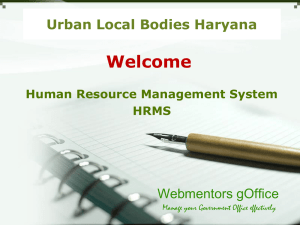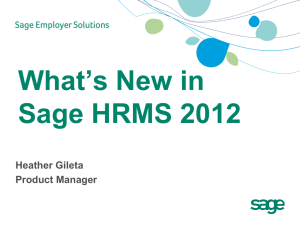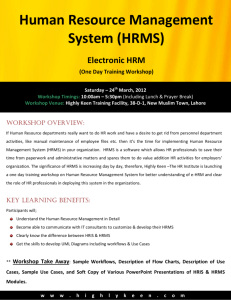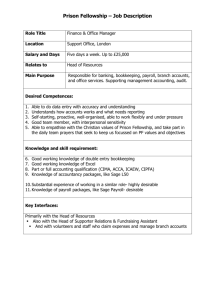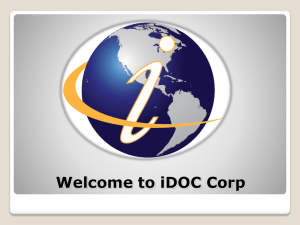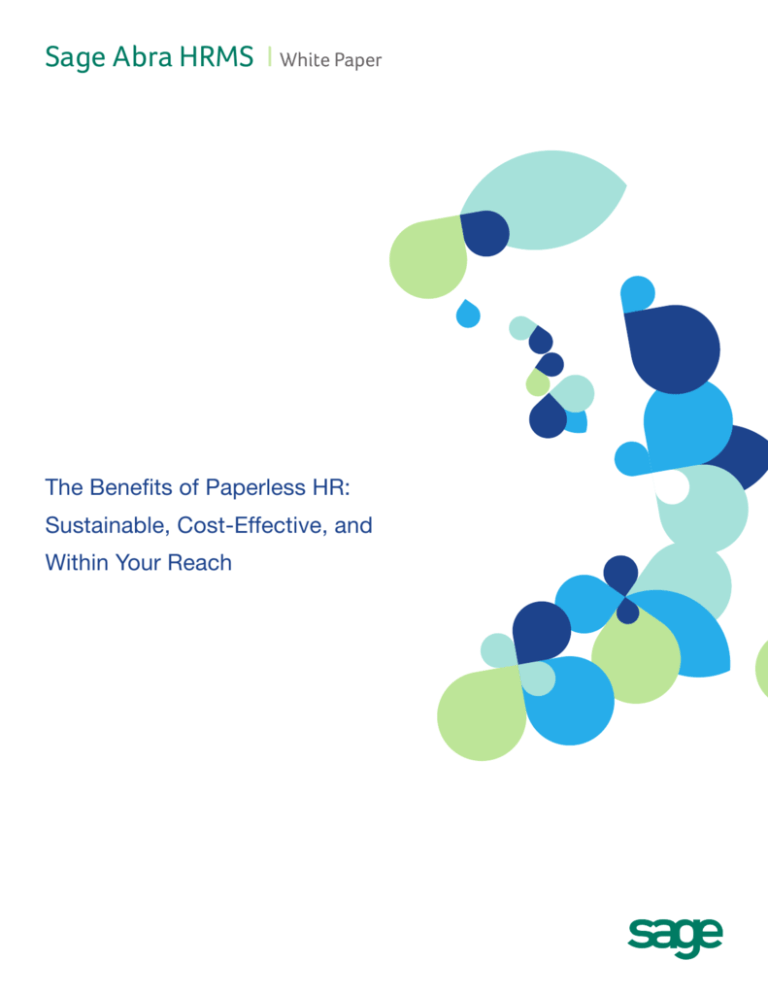
Sage Abra HRMS I White Paper
The Benefits of Paperless HR:
Sustainable, Cost-Effective, and
Within Your Reach
Sage Abra HRMS
Table of Contents
Introduction................................................................................................................... 1
Going Paperless With a Human Resource Management System......................... 1
Sustainability.................................................................................................. 1
Ease of Access to Key Information............................................................. 2
Lower Costs and Increased Efficiency....................................................... 3
HR Functions Improved by Technology.................................................................... 4
Applicant Tracking and Recruiting............................................................ 4
Employee Administration............................................................................ 4
Automated Forms and Approval Routing................................................. 4
Online Benefits Enrollment......................................................................... 5
Automated Benefits Carrier Connectivity................................................ 5
Paperless Payroll............................................................................................ 5
Conclusion..................................................................................................................... 5
Introduction
Sage Abra HRMS
For some time, HR professionals have aspired to create a “paperless office” with automated
technology to create, store, and manage all of the employee information necessary to run a
business effectively. Today the technology exists to turn this goal into reality with a desirable
Return on Investment (ROI). Current business trends toward environmental sustainability
provide the additional impetus to make the business case for paperless HR today, to help
support the workforce of tomorrow.
Increasingly, reducing the use of paper in business processes will become a necessary step
toward corporate sustainability efforts. Some global and regional companies are pushing
sustainability initiatives not only within their own operations, but also out into the supply chain,
encouraging vendors and partners to implement greener business practices. “Going green” is
a competitive response to changes in social attitudes and to the expectations of customers,
employees, and stakeholders.
Because of the many paper-intensive administrative processes in the Human Resources
department, it is a great area to embrace corporate sustainability objectives by eliminating
paper. Going paperless also saves costs and increases the efficiency and accuracy of HR
functions. It can even help with recruiting and engagement—many sought-after job candidates
and top-performing employees are passionate about environmental causes. This white paper
provides information on the benefits of a paperless HR department and the technology for
putting it in place.
Going Paperless With a Human Resources Management System
The principal technology tool to help you achieve a paperless HR department is Human
Resources Management System (HRMS) software. This central system is connected to all
HR-related processes. A notable feature is that employees and managers interact directly
with the HRMS through self-service functionality, which eliminates the delay, inaccuracies, and
inefficiencies of a paper-bound system. Moving to a paperless HR department can provide
many benefits for your organization, including the following:
Sustainability and a Greener Reputation
Even a casual observer of social trends would recognize the increased attention given to
environmental issues in the last 20 years. The environment issue is the subject of an ongoing
national conversation, debated daily in the news and in state and federal government. The
Millennial Generation—the next generation of employees, job candidates, and customers—was
raised online and is socially connected. Many of these younger people dedicate themselves to
good environmental stewardship.
1
Sage Abra HRMS
Not surprisingly, companies have made environmental sustainability a part of their business
plans. Consider the following points made in a 2011 study of global executives:1
• Sustainability spending survived the economic downturn, with almost 60% of companies increasing their investment in 2010.
• All companies surveyed recognized that a reputation for sustainability grows the value of their brands.
• Companies from diverse industries uniformly recognized the competitive significance of sustainability.
• Institutional investors are increasingly looking at sustainability. For example, “The Carbon Disclosure Project” now represents investors with $64 trillion under management.
• Corporate green initiatives have become a growing consideration
for job seekers.
Additionally, a separate 2011 survey of U.S. companies found that 69%
of the companies surveyed have green programs in place.2 The most
common green practice was “recycling and paper reduction.”3 Going
paperless in your HR department is a solid first step toward going
green as an organization.
Intangible Benefits
of Going Green
Some benefits of green initiatives are
hard to measure but may create a
competitive advantage. Enhanced
reputation helps attract key talent, as
Easier Access to Key Workforce Information for
Decision Making
To be successful, a business must make better decisions than its competitors.
Better decision-making hinges on the right people gaining access to the right
information at the right time. As a practical business benefit, an HRMS
empowers your HR team, management, and when appropriate, even
employees, with ready access to key information. All relevant information
about present and past employees is stored electronically, in a secure
centralized location.
Johnson & Johnson’s senior director
of worldwide health and safety, Al
Iannuzzi, acknowledged to the MIT
Sloan Management Review: “The highpotential new MBA students coming
out are interested in working for a
responsible company. So if we weren’t
doing this type of stuff, they would
probably be looking elsewhere, at least a
percentage.”4
When a decision requires an understanding of the company’s workforce,
self-service functionality in your HRMS can provide key decision-makers
with information about employees, performance, programs, benefits,
and workforce costs. You can access this information in real time and
generate a variety of reports on demand. Further, the HR department
can provide managers, supervisors, and executives with access to specific workforce
information, tailored for their business roles. Employees can also use self service. For example,
employees can access benefit plans, training announcements, company policies, payroll
history, and time-off balances—all without the need for time or resources from HR staff.
1 MIT Sloan Management Review & The Boston Consulting Group, “Sustainability: The ‘Embracers’ Seize Advantage,”
Winter 2011, p.5.a
2 Buck Consultants, a Xerox company, “Green Programs Save ‘Green,’ Buck Consultants Survey Reveals More U.S. Employers Measuring Cost Savings Stemming From Environmental Efforts,” April 11, 2011.
3 Ibid.
4 MIT Sloan Management Review & The Boston Consulting Group, “Sustainability: The ‘Embracers’ Seize Advantage,”
Winter 2011, p.16.
2
Sage Abra HRMS
Lower Costs and Increased Efficiency
An HRMS can help your organization lower costs in several ways: reduced supply costs, improved
accuracy, and more efficient routing and approval of electronic forms and requests. Going paperless not
only eliminates the cost of the paper itself, but it also reduces the expense of printing, delivery, handling,
and storage of your documents.
Likewise, time and resources are saved because employees can directly interact with
the HRMS through self-service functionality, which reduces the cost associated with
data entry. Employees take responsibility for entering some data, such as a time-off
request, into the HRMS, which can be immediately reviewed and approved by
managers. Self service delivers the following benefits:
• It increases the accuracy of HR data by reducing the typographical data-entry
errors common to a paper-bound system.
• The increased accuracy means that less time is devoted to detecting and
remedying mistakes.
HR Can Be a Leader in
Green Initiatives
According to a survey
of companies by Buck
Consultants, in 47% of
companies with green
initiatives, the HR department
owns the program.5
• Employees and their managers can complete routine requests and
administration without HR involvement, such as requests for time off,
changes to W-4 information, and updated contact information.
In summary, through the use of electronic, automated forms, the HRMS allows for more efficient routing
of employee requests and management approvals. These are just more examples of how the use of an
HRMS drives companywide efficiency for HR processes and will improve the level of service that HR can
offer to the company.
Green Dollars and Cents
In a recent pilot program in Wisconsin’s manufacturing industry, sustainability projects
generated an average ROI of 485%. A June 2011 report by the Profitable Sustainability
Initiative provided these details:6
Cost Savings:
$26.9 million projected over five years
Increased/Retained Sales:
$23.5 million projected over five years
Investment:
Total Economic Impact:
Return on Investment:
$3.6 million across more than 87 projects
$54 million projected over five years
Across all projects, ROI averaged 485%. Transportation
sustainability projects achieved an ROI of 1,995%!
5 “Green Company Programs Increase in U.S.,” HR News, April 21, 2010. Accessed at SHRM.org.
6 Manufacturing Extension Partnership, “Wisconsin Profitable Sustainability Initiative First Report,” June 2011.
3
HR Functions Improved by Technology
Sage Abra HRMS
How many of your current HR processes can be completed without paper? All of them—if you
utilize the right technology. An HRMS is a centralized system that provides a single, reliable tool for
performing each function of a previously paper-based system with increased efficiency, cost savings,
and enhanced analytics. Your organization can strip the paper out of any of these HR functions:
•
Online Applicant Tracking and Recruiting: HR managers can locate and recruit better qualified candidates for open positions. Positions are posted online, and resumés and applications are also received electronically. In that format, they can be searched and filtered for the appropriate skill set. Resumés and applications can then be routed to management for further review. Some systems can even help schedule candidate interviews and, if approved, transmit the offer letter. If the candidate is employed by the company, the resumé and application are then stored in the new electronic personnel file.
•
Employee Administration: The employee self-service feature of the system, described above, performs many routine HR functions while keeping sensitive employee data safe and secure. The HR manager can determine how workforce data is distributed based on the security profile of each user. With these security protocols in place, the system allows employees to initiate requests for time off and training, review their payroll history, see what benefits they signed up for, access company policies, and much more.
•
Automated Form Delivery and Approval Alerts: In addition to monitoring HR activities, tools exist to go beyond monitoring to help the approval workflow process. These tools auto-fill, generate, and deliver forms based on specific business events and then help expedite them through the approval process. For example, a new employee entered into the HRMS would trigger the delivery of onboarding forms, a request for orientation training, a form to get the employee into the payroll system, and so on. These forms would be automatically sent to the correct people and alerts would ensure their quick routing through the entire approval process, all without ever having to say, “Are you done with that?”
Ways to Go Green in HR
In 2010, Buck Consultants found that the companies they surveyed were embracing
paperless HR practices.
78% have internal green communication programs to reduce paper usage.
72% use online HR communications.
58% have internal communication programs that offer employees tips and information on being environmentally friendly.
57% use online summary plan descriptions.
4
•
Online Benefits Enrollment: Empowering employees to learn about benefits and make their selections online can significantly shorten the enrollment cycle. Online benefits enrollment provides complete and timely information about benefits without the use of costly paper packets. Employees can then input their information and selections and even update that information in the event of future life changes. Benefit managers can quickly handle open enrollment, through a simple review and approval of submissions, without the need for
time-consuming data reentry.
•
Automated Benefits Carrier Connectivity: This technology gathers,
formats, and electronically transmits data about enrolled employees
to benefits providers. This automated system avoids the costly errors
typical of a paper-based system, including duplicate data entry,
typographical errors, and “missed enrollments.”
•
Electronic Payroll: Integrating an automated payroll component into
an HRMS system empowers the company to pay employees
electronically. Direct deposits and payroll debit cards save the costs
associated with processing and issuing paper paychecks while
providing employees with more convenient ways to receive their pay.
Sage Abra HRMS
Greener Pay
In 2009, Walmart transitioned to entirely
paperless payroll, using direct deposit
and payroll paycards only to deliver pay to
over 1.4 million U.S. employees.7 Green
payroll practices can also contribute to the
bottom line at much smaller organizations.
According to HR Magazine, the
comptroller of the currency estimates that
employers save about $2 per paycheck
Conclusion
The concept of improving efficiency by using an HRMS to go paperless
is not new to HR professionals. What’s evolving is the increased corporate
focus on sustainability and green initiatives. Recent studies suggest this
issue will be a persistent component of future business plans. As
companies respond to the demands of their customers, investors,
employees, and other stakeholders, green practices will become a
regular way of doing business.
when they pay electronically. Employers
save another $8 to $10 for each check
they do not have to cancel and reissue—
approximately 4 million paper paychecks
are lost or stolen each year.8 For the HR department, using your technology to go paperless is a great way to support company
objectives and set a positive example for the rest of the organization. The benefits are clear: lower
costs, a better corporate image, and improved productivity in the HR department. Equally clear is the
feasibility of implementing an HRMS—going green is definitely within your reach.
7 Aliah D. Wright, “Wal-Mart Eliminates Paper Paychecks,” SHRM website.
8 Cathy S. Beyda, “A Greener Wage,” HR Magazine, Vol. 55, No. 3, March 2010.
5
About Sage Abra HRMS
As the longest-running HRMS solutions provider, Sage delivers flexible,
scalable, and comprehensive tools to help you automate and improve your
business processes and produce the information you need to better manage
your workforce. Unlike other HRMS solutions, Sage Abra HRMS is the only
solution that combines low cost, ease of use, and the ability to dynamically
share information with executives, managers, and others both inside and
outside your organization. Sage Abra is comprised of HR, payroll, benefits,
training, and compliance solutions developed specifically for midsized
businesses. Its flexible design provides a comprehensive array of features and
the powerful reporting and analysis capabilities needed to efficiently manage
your workforce.
To learn more, please visit: www.SageAbra.com
Sage
888 Executive Center Dr. W., Suite 300 | St. Petersburg, FL 33702 | www.SageAbra.com
©2011 Sage Software, Inc. All rights reserved. Sage, the Sage logos, and the Sage product and service
names mentioned herein are registered trademarks or trademarks of Sage Software, Inc., or its affiliated
entities. All other trademarks are the property of their respective owners. 07/11

